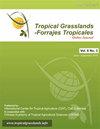Establishment of a core collection of Cynodon based on morphological data
IF 0.7
4区 农林科学
Q3 AGRICULTURE, DAIRY & ANIMAL SCIENCE
引用次数: 2
Abstract
In a field plot study conducted in Danzhou, Hainan province, China, a total of 537 wild Cynodon accessions from 22 countries and classified into 11 groups according to taxonomy and origin, were characterized in terms of 11 phenotypic traits in order to construct a core collection. For this, the optimal strategy was developed by screening within the following method levels: (i) 7 sampling proportions (5, 10, 15, 20, 25, 30 and 35%); (ii) 3 sampling methods (preferential sampling, deviation sampling and random sampling); (iii) 5 clustering methods [single linkage, completed linkage, median linkage, unweighted pair-group average (UPGMA) and Ward’s method]; (iv) 3 genetic distances (Euclidean distance, Mahalanobis distance and principal component distance); and (v) 3 sampling proportions within groups (simple, logarithmic and square root proportions). Mean difference percentage, variance difference percentage, coincidence rate of range and variation coefficient changing rate were the criteria adopted for evaluating how well the core collection represented the original collection. The correlation between the original and core collections was determined for comparison. The core collections were validated with the sample distribution diagram of the main components. Results showed that the optimal sampling method for constructing a Cynodon core collection was preferential sampling, the optimal sampling proportion being 20%. The optimal sampling proportion within groups was the square root proportion, the optimal genetic distance was Mahalanobis distance and the optimal clustering method was UPGMA. The proposed core collection of Cynodon is composed of 108 accessions; it was constructed following the optimal sampling strategy identified and retained the original collection ́s phenotypic diversity, phenotypic trait correlations and phenotypic group structure. Thus, this collection could be considered a representative sample of the entire resource.基于形态资料的食蟹蟹核心群的建立
在海南儋州对来自22个国家的537份野生食蟹属植物进行了样地研究,根据分类和来源将其划分为11个类群,并根据11个表型性状对其进行了鉴定。为此,通过在以下方法水平中筛选,制定了最佳策略:(i) 7个抽样比例(5、10、15、20、25、30和35%);(二)三种抽样方法(优先抽样、偏差抽样和随机抽样);(iii) 5种聚类方法[单链接、完全链接、中位数链接、未加权对组平均(UPGMA)和Ward法];(iv) 3个遗传距离(欧几里得距离、马氏距离和主成分距离);(v)组内抽样比例(单比例、对数比例和平方根比例)。平均差值百分比、方差差值百分比、范围符合率和变异系数变化率是评估核心集合代表原始集合程度的标准。确定原始集合和核心集合之间的相关性以进行比较。使用主要组件的样例分布图验证了核心集合。结果表明,优选抽样是构建食蟹蟹岩心标本的最佳抽样方法,最佳抽样比例为20%。组内最佳抽样比例为平方根比例,最佳遗传距离为马氏距离,最佳聚类方法为UPGMA。拟议的Cynodon核心合集由108个条目组成;它是根据确定的最佳采样策略构建的,并保留了原始集合的表型多样性、表型性状相关性和表型群结构。因此,可以将此集合视为整个资源的代表性样本。
本文章由计算机程序翻译,如有差异,请以英文原文为准。
求助全文
约1分钟内获得全文
求助全文
来源期刊

Tropical Grasslands-Forrajes Tropicales
Agricultural and Biological Sciences-Agronomy and Crop Science
CiteScore
1.60
自引率
0.00%
发文量
36
审稿时长
16 weeks
期刊介绍:
The Journal publishes, in English or Spanish, Research Papers and Short Communications on research and development, as well as contributions from practitioners (Farmer Contributions) and Review Articles, related to pastures and forages in the tropics and subtropics. There is no regional focus; the information published should be of interest to a wide readership, encomprising researchers, academics, students, technicians, development workers and farmers.
In general, the focus of the Journal is more on sown (''improved'') pastures and forages than on rangeland-specific aspects of natural grasslands, but exceptions are possible (e.g. when a submission is relevant for a particularly broad readership in the pasture and forage science community).
The Journal will also consider the occasional publication of associated, but closely related, research in the form of an additional scientific communication platform [e.g. a re-make of the former Genetic Resources Communication series of the former Division of Tropical Crops and Pastures of the Commonwealth Scientific and Industrial Research Organisation (CSIRO), Australia].
Areas of particular interest to the Journal are:
Forage Genetic Resources and Livestock Production[...]
Environmental Functions of Forages[...]
Socio-economic Aspects[...]
Topics within the aforementioned areas may include: Diversity evaluation; Agronomy; Establishment (including fertilization); Management and utilization; Animal production; Nutritive value; Biotic stresses (pests and diseases, weeds); Abiotic stresses (soil fertility, water, temperature); Genetics and breeding; Biogeography and germplasm collections; Seed production; Ecology; Physiology; Rhizobiology (including BNF, BNI, mycorrhizae); Forage conservation; Economics; Multilocational experimentation; Modelling.
 求助内容:
求助内容: 应助结果提醒方式:
应助结果提醒方式:


